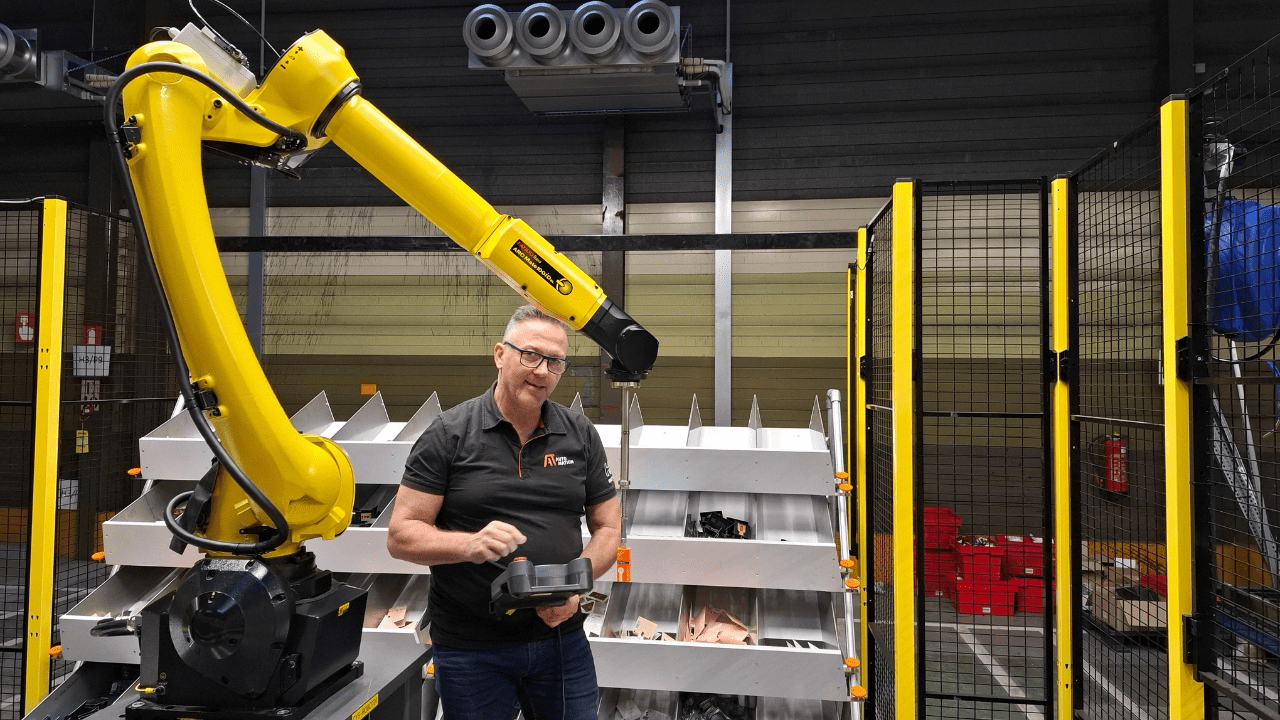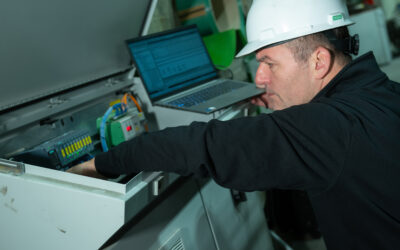Jean, the driving force behind our robotics department

In the rapidly evolving world of manufacturing, it’s essential to embrace technologies that increase efficiency, improve quality, and reduce costs. While robotics has been a key player in the industry for decades, it has recently gained even more ground as an automation solution. At AT-Automation, we have over 30 years of experience in programming and implementing robotic solutions. To meet the increasing demand from customers, we established a dedicated division for robotics, led by Jean Storken, our experienced robotics team leader.
Why robotics?
The establishment of the robotics division was a logical step for AT-Automation. Ard Triepels, the owner of AT-Automation, gained extensive experience during the early years of his entrepreneurship through automation projects in which robots played a key role. While AT-Automation has grown significantly as an integrator of industrial automation solutions in the broadest sense, the desire to establish a dedicated robotics division always remained.
Ard and Jean Storken know each other from their time at VDL Nedcar, where Jean was responsible for the maintenance of robotic production processes. After working for several years as a service technician in the technical department, Jean discovered his passion for robotics. Following his time at Nedcar, he pursued opportunities elsewhere to fully specialize in the automation of production processes using robots.
Their shared vision of the power of robotics—optimizing production processes, reducing ergonomically strenuous work, and increasing efficiency—formed the foundation for the establishment of our robotics division. AT-Automation recognizes the enormous benefits of this technology and has assembled a specialized team to help companies optimize their production processes through the implementation of robots.
What does AT-Automation’s robotics division do?
AT-Automation’s robotics division develops tailor-made solutions to optimize industrial production processes using robotics. We offer a comprehensive service package, from simulation and design to programming and commissioning. Under Jean’s leadership, our team works closely with customers to address specific automation challenges.
Our projects range from integrating robots into existing production lines to end-of-line handling and palletizing. Whether it’s automating repetitive tasks, increasing production speed, minimizing human errors, or improving overall efficiency, we deliver complete solutions tailored to each customer’s needs.
We provide expert programming of robotic arms and systems, reliable service and maintenance for robotic installations, and integration of mechanical components such as conveyor belts and End of Arm Tooling (EoAT). Additionally, we offer solutions for both depalletizing at the start of the line and palletizing at the end of the line. At AT-Automation, we integrate both new and refurbished robots to maximize our customers’ efficiency and productivity.
What sets us apart?
What makes our robotics division unique is the collaboration with our control engineering department. By combining these two departments, we can deliver the complete automation story for our customers. From robot design and programming to the integration of control systems and on-site technical implementation, we offer an end-to-end solution with a single point of contact. This ensures efficiency, peace of mind, and seamless implementation.
From idea to implementation
At AT-Automation, the robotics division is not just about technology but also about building strong relationships with our customers. Jean personally takes the lead in both the initial contact and project execution, as well as in after-sales service. From analyzing technical challenges and developing customized solutions to the actual implementation of robots on-site, Jean is the driving force behind the process.
This personal approach allows us to act quickly and flexibly, enabling us to deliver precisely what the customer needs.
The power of robotics
Integrating robots into production processes offers numerous advantages for companies. Robots can operate 24/7 without fatigue, ensuring a high level of precision and reliability. The assembly of the four-hundredth item will be just as precise as the first. This results in a faster ROI as robots take over repetitive tasks and boost productivity.
Moreover, robots often perform physically demanding tasks, reducing the workload for employees and improving overall workplace safety.
The future of robotics in industry
The demand for robotics will continue to grow in the coming years, driven by the need for increased automation due to labor shortages. This makes robots indispensable. AT-Automation is responding to this trend by not only integrating industrial robots but also incorporating new technologies such as AI to optimize software and robot programming.
“Robotics is an essential tool for the future of manufacturing. It helps companies structure their processes more efficiently and effectively while contributing to a safer and more ergonomically responsible work environment,” says Jean Storken.
The future of AT-Automation’s robotics division
We believe that robotics will be a crucial factor in our customers’ success, and we are ready to guide them through this technological transformation. With over 30 years of experience, in-depth expertise, and a hands-on approach, AT-Automation offers not just robots but also the assurance of a customized solution. Our mission is to help companies grow, work more efficiently, and prepare for the future by harnessing the full power of robotics.
Curious about what robotics can do for your company? Contact AT-Automation and discover the possibilities!
Stay up to date
Receive the newsletter in je inbox every month.
Or follow us
Share this article
Others also viewed
Time to revise or replace your PLC? Use the decision tree
A PLC is a crucial component of many industrial processes. However, like any technology, a PLC has a lifespan, and sooner or later, the question arises: should we revise or replace it? Use this decision tree…
What should you consider when choosing a SCADA/MES system?
A good SCADA/MES system plays a crucial role in this. It enables companies to collect production data, monitor processes, and intervene immediately in case of failures or deviations. However, not every system…
Global robotics trends 2025
The global market for industrial robots continues to grow and has reached a record high of $16.5 billion in 2025. Innovations in technology, changing market conditions, and new applications are driving the increasing demand for automation.



